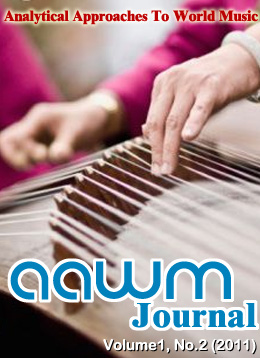 |
| |
 |
 |
 |
 |
 |
|
AAWM JOURNAL Volume 1, No. 2 (2011) |
 |
 |
| Volume 1, No. 2 (2011) |
| |
 |
 |
| Fluctuant Grouping in a Silk-and-Bamboo Melody |
| John Roeder |
| Liuban is one of a constellation of old tunes (qupai) that are foundational to music of China, and in particular to the rich "Silk-and-Bamboo" music (jiangnan sizhu) of the lower Yangzi region. This essay highlights some of the extraordinary qualities of Liuban by treating its grouping structure not as fixed, but as constructed dynamically by the listener... more >> |
| |
 |
 |
The Hurrian Pieces, ca. 1350 BCE:
Part Two—From Numbered Strings to Tuned Strings |
| Jay Rahn |
| The first part of this study concluded that on the basis of numbered strings and their pairwise ordering (from left to right and top to bottom) on cuneiform tablets, one can identify within h.6, the earliest known piece of music that is notated from beginning to end, structural relationships of similarity, adjacency, and analogy as well as statistical tendencies. Further, most of these tendencies appear throughout the other 34 earliest pieces, which are highly fragmentary, and these tendencies can be understood in terms of the structural relationships identified in h.6... more >> |
| |
 |
 |
Voice-Leading Considerations In Edo-Period Jiuta-Tegotomono:
A New Analytical Approach |
| Henry Burnett |
| This article seeks to clarify the modal voice-leading structure of Japanese Edo-period chamber music (roughly the music composed in both the kansai and kanto areas from 1690 to 1868), in particular that of shamisen jiuta tegotomono. In doing so, a new theory of modal organization is presented through detailed analyses of several important works within the genre, using Ishikawa Kōtō’s seminal piece Aoyagi as a case study... more >> |
| |
 |
 |
| Tradition and Innovation in the Bānsurī Performance Style of Pannalal Ghosh |
| Carl Clements |
| Pannalal Ghosh (1911–1960) is generally credited with the popularization of the bamboo flute (bānsurī) in modern Hindustani classical music. While the transverse flute already had a long history in the music of India, there does not seem to have been any extant tradition of Hindustani classical bānsurī playing in the 1930s and ‘40s when Pannalal Ghosh was adapting the bānsurī for the North Indian classical stage... more >> |
| |
 |
 |
Computational Models of Symbolic Rhythm Similarity:
Correlation with Human Judgments |
| Godfried T. Toussaint, Malcolm Campbell, Naor Brown |
| A novel approach to describing rhythmic relationships in music is introduced by means of three experiments designed to test computational measures of symbolic rhythm similarity against human judgments. The first experiment involves a group of six distinguished Afro-Cuban timelines that had previously been compared with respect to a variety of mathematical measures of rhythm similarity in the context of phylogenetic analysis of rhythms... more >> |
|
|
 |
|
 |
 |
|



